闽教版小学英语五年级上册知识点复习归纳
教材全解(知识清单)闽教版英语五年级上册
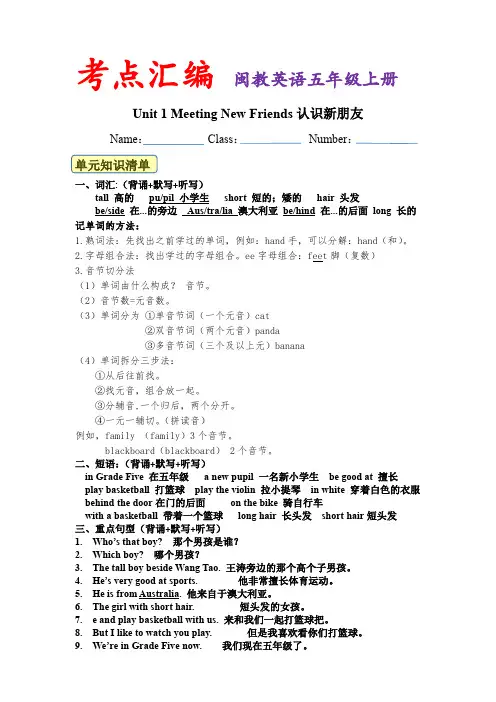
考点汇编闽教英语五年级上册Unit 1 Meeting New Friends认识新朋友Name:Class:Number:一、词汇:(背诵+默写+听写)tall 高的pu/pil 小学生short 短的;矮的hair 头发be/side 在...的旁边Aus/tra/lia 澳大利亚be/hind 在...的后面long 长的记单词的方法:1.熟词法:先找出之前学过的单词,例如:hand手,可以分解:hand(和)。
2.字母组合法:找出学过的字母组合。
ee字母组合:feet脚(复数)3.音节切分法(1)单词由什么构成?音节。
(2)音节数=元音数。
(3)单词分为①单音节词(一个元音)cat②双音节词(两个元音)panda③多音节词(三个及以上元)banana(4)单词拆分三步法:①从后往前找。
②找元音,组合放一起。
③分辅音,一个归后,两个分开。
④一元一辅切。
(拼读音)例如,family (family)3个音节。
blackboard(blackboard) 2个音节。
二、短语:(背诵+默写+听写)in Grade Five 在五年级 a new pupil 一名新小学生be good at 擅长play basketball 打篮球play the violin 拉小提琴in white 穿着白色的衣服behind the door在门的后面on the bike 骑自行车with a basketball 带着一个篮球long hair 长头发short hair短头发三、重点句型(背诵+默写+听写)1. Who’s that boy? 那个男孩是谁?2. Which boy? 哪个男孩?3. The tall boy beside Wang Tao. 王涛旁边的那个高个子男孩。
4. He’s very good at sports. 他非常擅长体育运动。
5. He is from Australia. 他来自于澳大利亚。
闽教版英语五年级上册知识点汇总
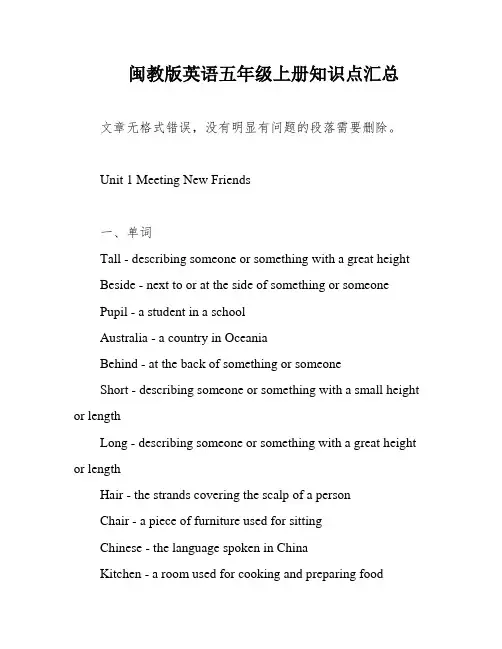
闽教版英语五年级上册知识点汇总文章无格式错误,没有明显有问题的段落需要删除。
Unit 1 Meeting New Friends一、单词Tall - describing someone or something with a great heightBeside - next to or at the side of something or someonePupil - a student in a schoolAustralia - a country in OceaniaBehind - at the back of something or someoneShort - describing someone or something with a small height or lengthLong - describing someone or something with a great height or lengthHair - the strands covering the scalp of a personChair - a piece of furniture used for sittingChinese - the language spoken in ChinaKitchen - a room used for cooking and preparing foodWatch TV - to view n programs二、词语Beside Wang Tao - next to or at the side of Wang Tao In Grade Five - studying in the fifth gradeThat boy - referring to a specific boyThe tall boy - referring to a boy with a great heightA new pupil - a student who recently joined the school Be from Australia - to come from AustraliaBe good at - to have a talent or skill in doing something On the bike - riding a bicycleBehind the door - at the back of the doorWith a basketball - holding a basketballBe good at sports - to have a talent or skill in sports With short hair - having short hairWith an umbrella - holding an umbrellaPlay basketball - to participate in a basketball game Play the lin - to perform on a linIn white - wearing white clothing三、重点句型、语法1.Who’s that boy。
闽教版英语五年级上册知识点汇总
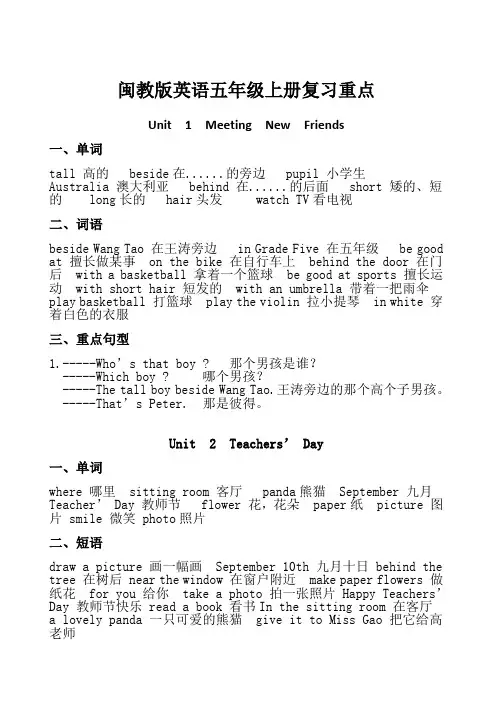
闽教版英语五年级上册复习重点Unit1Meeting New Friends一、单词tall 高的 beside在......的旁边 pupil 小学生Australia 澳大利亚 behind 在......的后面 short 矮的、短的 long长的 hair头发 watch TV看电视二、词语beside Wang Tao 在王涛旁边 in Grade Five 在五年级 be good at 擅长做某事 on the bike 在自行车上 behind the door 在门后 with a basketball 拿着一个篮球 be good at sports 擅长运动 with short hair 短发的 with an umbrella 带着一把雨伞play basketball 打篮球 play the violin 拉小提琴 in white 穿着白色的衣服三、重点句型1.-----Who’s that boy ? 那个男孩是谁?-----Which boy ? 哪个男孩?-----The tall boy beside Wang Tao.王涛旁边的那个高个子男孩。
-----That’s Peter. 那是彼得。
Unit 2 Teachers’ Day一、单词where 哪里 sitting room 客厅 panda熊猫 September 九月Teacher’ Day 教师节 flower 花,花朵 paper纸 picture 图片 smile 微笑 photo照片二、短语draw a picture 画一幅画 September 10th 九月十日 behind the tree 在树后 near the window 在窗户附近 make paper flowers 做纸花 for you 给你 take a photo 拍一张照片 Happy Teachers’Day 教师节快乐 read a book 看书In the sitting room 在客厅a lovely panda 一只可爱的熊猫 give it to Miss Gao 把它给高老师三、重点句型1、 -- Where is the boy/girl? 那个男孩/女孩在哪?-- He/She is + 地点他/她在......-- Where are the boys/girls ?那些男孩/女孩在哪?-- They are + 地点他们在......询问某人正在做什么:---What’s he doing ?.他正在干什么?---He’s drawing a panda。
闽教版英语五上重要考点总结
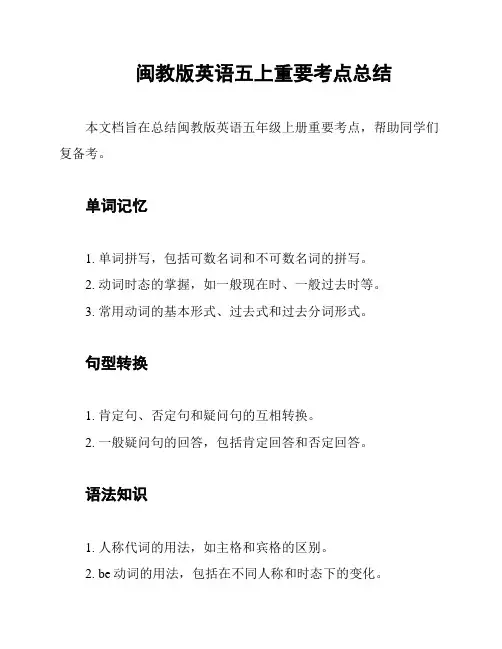
闽教版英语五上重要考点总结
本文档旨在总结闽教版英语五年级上册重要考点,帮助同学们复备考。
单词记忆
1. 单词拼写,包括可数名词和不可数名词的拼写。
2. 动词时态的掌握,如一般现在时、一般过去时等。
3. 常用动词的基本形式、过去式和过去分词形式。
句型转换
1. 肯定句、否定句和疑问句的互相转换。
2. 一般疑问句的回答,包括肯定回答和否定回答。
语法知识
1. 人称代词的用法,如主格和宾格的区别。
2. be动词的用法,包括在不同人称和时态下的变化。
3. 一般现在时的应用场景,如描述经常发生的事情。
4. 一般过去时的应用场景,如过去发生的事件。
阅读理解
1. 抓住关键词,理解文章主旨。
2. 根据语境推测词义。
3. 根据文章内容回答问题,理解细节信息。
4. 根据文章意思,完成相关练。
听力理解
1. 训练听力,提高听懂对话和短文的能力。
2. 根据听到的内容回答问题,理解细节信息。
3. 根据对话和短文的意思,完成相关练。
书面表达
1. 用自己的语言描述图片或短文内容。
2. 根据题目要求进行写作,表达清晰准确。
以上是五年级上册的重要考点总结,同学们在复备考过程中可以参考本文档进行针对性复,提升英语研究水平。
祝同学们考试顺利!
(800字)。
闽教版五年级上英语词汇和句型知识汇总
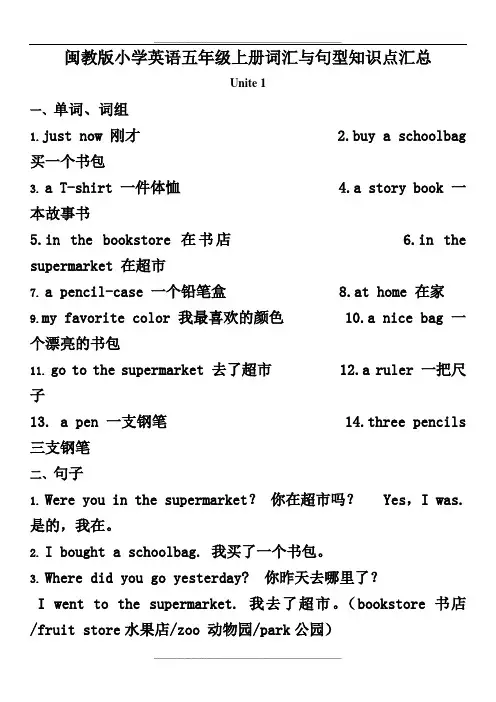
闽教版小学英语五年级上册词汇与句型知识点汇总Unite 1一、单词、词组1.just now 刚才2.buy a schoolbag 买一个书包3.a T-shirt 一件体恤4.a story book 一本故事书5.in the bookstore 在书店6.in the supermarket 在超市7.a pencil-case 一个铅笔盒 8.at home 在家9.my favorite color 我最喜欢的颜色 10.a nice bag 一个漂亮的书包11.go to the supermarket 去了超市 12.a ruler 一把尺子13. a pen 一支钢笔 14.three pencils 三支钢笔二、句子1.Were you in the supermarket?你在超市吗? Yes,I was. 是的,我在。
2.I bought a schoolbag. 我买了一个书包。
3.Where did you go yesterday? 你昨天去哪里了?I went to the supermarket. 我去了超市。
(bookstore 书店/fruit store水果店/zoo 动物园/park公园)Unite 2一、单词、词组1.have a good time 过得愉快2.in England 在英国3.visit Big Ben 参观大本钟4.take some photos 照了一些照片5.so big 很大6.visit the Great Wall 参观长城7.play basketball 打篮球 8. do the homework 做家庭作业9.do housework 做家务 10.in your summer vacation 在你的暑假11.from the USA 来自美国 12. a new student 一个新的学生13.play the piano 弹钢琴 14.swim in the sea二、句子1.Did you have a good time in England? 你在英国过得愉快吗?Yes,I did. 是的。
闽教版英语五年级上册知识点汇总
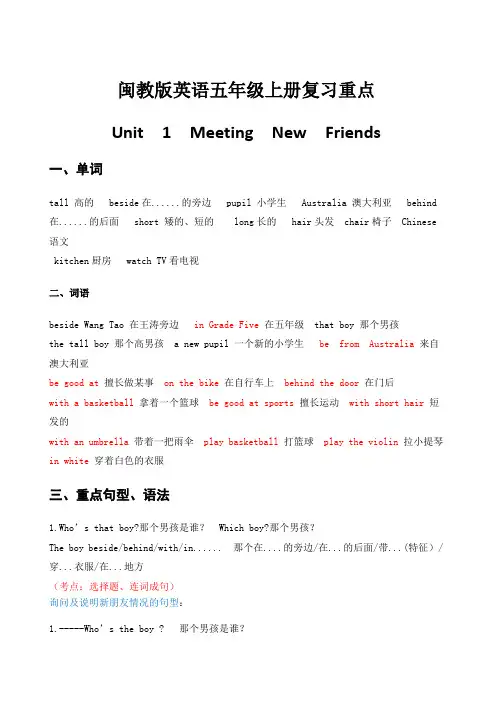
闽教版英语五年级上册复习重点Unit1Meeting New Friends一、单词tall 高的 beside在......的旁边 pupil 小学生 Australia 澳大利亚 behind 在......的后面 short 矮的、短的 long长的 hair头发 chair椅子 Chinese 语文kitchen厨房 watch TV看电视二、词语beside Wang Tao 在王涛旁边in Grade Five在五年级 that boy 那个男孩the tall boy 那个高男孩 a new pupil 一个新的小学生be from Australia 来自澳大利亚be good at擅长做某事on the bike 在自行车上 behind the door 在门后with a basketball拿着一个篮球be good at sports 擅长运动with short hair 短发的with an umbrella 带着一把雨伞 play basketball打篮球play the violin拉小提琴in white 穿着白色的衣服三、重点句型、语法1.Who’s that boy?那个男孩是谁? Which boy?那个男孩?The boy beside/behind/with/in...... 那个在....的旁边/在...的后面/带...(特征)/穿...衣服/在...地方(考点:选择题、连词成句)询问及说明新朋友情况的句型:1.-----Who’s the boy ? 那个男孩是谁?-----Which boy ? 哪个男孩?------The tall boy beside Wang Tao. 王涛旁边的那个高个子男孩。
------That’s Peter. 那是彼得。
The boy beside Wang Tao. 那个王涛旁边的男孩。
(人名前面不加the , a )The boy beside the door. 那个门后面的男孩。
考点汇总(知识清单)闽教版英语五年级上册
闽教英语五年级上册in Grade Five 在五年级 a new pupil 一名新小学生be good at 擅长play basketball 打篮球play the violin 拉小提琴in white 穿着白色的衣服behind the door在门的后面on the bike 骑自行车with a basketball 带着一个篮球long hair 长头发short hair短头发1. Who’s that boy? 那个男孩是谁?2. Which boy? 哪个男孩?3. The tall boy beside Wang Tao. 王涛旁边的那个高个子男孩。
4. He’s very good at sports. 他非常擅长体育运动。
5. He is from Australia. 他来自于澳大利亚。
6. The girl with short hair. 短头发的女孩。
7. e and play basketball with us. 来和我们一起打篮球把。
8. But I like to watch you play. 但是我喜欢看你们打篮球。
9. We’re in Grade Five now. 我们现在五年级了。
1.ch / tʃ/ chair Chinese2.tch / tʃ/ kitchen watch TV(1)in在…里面例:in the bag 在书包里(2)on在…上面例:on the chair 在椅子上(3)under在…下面例:under the desk在书桌下面(4)near 在…附近例:near the window 在窗户附近(5)beside 在….旁边例:beside Lily 在Lily旁边(6)behind 在…后面例:behind the door在门后be动词就是:is, am, are , 意思:“是”。
I我;you你,你们;he他,she她,it它(备注:father相当于he; Sally相当于she; dog相当于it。
闽教版英语五年级上册知识要点(1-8单元)
五年级英语上册知识点总结(1--8单元)Unit1一、词组in Grade Five在五年级from+国家:来自……国家be good at:擅长……beside Wantao:在王涛的旁边a new pupil一个新学生on the bike:骑在自行车上behind the door:在门后with a basketball:拿着一个篮球in+颜色:穿……颜色的衣服with a basketball拿着一个篮球with short hair有短头发二、句子:e and play basketball with us.(和我们一起打篮球吧。
)2.I like to watch you play.我喜欢看你玩。
Unit2一、词组in the sitting room在客厅behind the tree在那棵树的后面near the window在那扇窗的附近in the classroom在教室里draw a panda画一只熊猫a lovely panda一只可爱的熊猫read a book看一本书make paper flowers制作纸花10th第10my new drawing我的新画作Happy Teachers’Day教师节快乐a nice picture一幅漂亮的画give...to...把......给......say...to...对......说......for you给你take a photo拍照二、句型/句子:this(单数)these(复数)This is new drawing.These are English books.(单用is,复用are)Unit3一、词组National Day国庆节go for a holiday去度假live in Taibei住在台北go with me和我去by+交通工具:乘坐……交通工具turn on打开电源turn off关闭电源go by plane坐飞机Tell...about...告诉......关于......二、句子:Please tell me about it.请告诉我更多事情。
闽教版小学英语 五年级上英语复习重点
五年级上全部背背背!!!!!!!!!!!!! with short hair 留着短发 with long hair 留着长发 with a basketball 拿着篮球 with an umbrella 拿着雨伞 beside Wang Tao 王涛旁边 behind the door 门后面
on the bike 自行车上面 画图画 in the sitting room 在客厅里 lovely panda 可爱的熊猫 好书 nice teacher 好老师
读书 折纸花 去度假
看电视 坐飞机
坐火车 打开电脑 go to the cinema 去电影院 go to the museum 去博物馆 go the the hospital watch a film 看电影
坐下
划船 踢足球
打篮球 拉小提琴 play chess 下象棋 play in the park 在公园里玩 很远
直走 向右转 坐的士
wait a minute 五遍
和…回家路上
擅长运动 抄写新单词。
闽教版小学英语五年级上册Unit 1 单元知识梳理
闽教版小学英语五年级上册单元知识梳理Unit 1 Meeting New Friends单词:that [ðæt] (指较远的人或事物)那,那个which [wɪtʃ] 哪一个tall [tɔːl] 高的beside [bɪˈsaɪd] 在旁边pupil [ˈpjuːpl] 学生Australia [ɒˈstreɪliə] 澳大利亚behind [bɪˈhaɪnd] 在……的后面short [ʃɔːt] 短的umbrella [ʌmˈbrelə] 雨伞Part A◆语言技能目标1、能用英语描述他人。
课文学习Hello, Lily. 你好,莉莉。
Hi, Yang Ming. How are you? 嗨,杨明。
你怎么样?I’m fine, thank you. 我很好,谢谢。
We’re in Grade Five now. 我们现在五年级了。
Yes. 是的。
Who’s that boy? 那个男生是谁?Which boy? 哪个?The tall boy beside Wang Tao. 王涛旁边的那个高个子男生。
That’s Peter. He’s a new pupil. 那是彼得。
他是新来的学生。
He’s from Australia. 他来自澳大利亚。
Can he play basketball? 他会打篮球吗?Yes, he can. He’s very good at sports. 是的,他会。
他很擅长运动。
句型巩固:Who’s that boy?那个男生是谁?Who’s that boy?Which boy? 哪个男生?Which boy?The boy . The boy on the bike. 在自行车上的那个男生。
That’s . That’s Wang Tao. 那是王涛。
Who’s that boy? Who’s that boy?Which boy? Which boy?The boy behind the door. 门后面的那个男生。
- 1、下载文档前请自行甄别文档内容的完整性,平台不提供额外的编辑、内容补充、找答案等附加服务。
- 2、"仅部分预览"的文档,不可在线预览部分如存在完整性等问题,可反馈申请退款(可完整预览的文档不适用该条件!)。
- 3、如文档侵犯您的权益,请联系客服反馈,我们会尽快为您处理(人工客服工作时间:9:00-18:30)。
闽教版小学英语五年级上册知识点复习归纳Unit 1:In Unit 1.we learn about different words and phrases related to describing people's appearance and n。
For example。
"tall" means someone is of a greater height。
while "behind" means something is located at the back of another thing。
We also learn about the ___'s n。
such as "The boy beside Wang Tao" or "The boy behind the door." nally。
we learn about different countries。
including Australia。
and how to say where someone is from。
Finally。
we learn about different activities。
___.Unit 2:In Unit 2.we learn about different words and phrases related to n and time。
For example。
"where" is used to ask about a specific n。
while "sitting room" refers to a specific room in a house。
We also learn about the month of ___。
we learn about different adjectives to describe things。
such as "lovely" to describe something cute or charming。
and "kind" to describesomeone who is friendly and helpful。
Finally。
we learn about different objects。
such as flowers。
paper。
and pictures。
andhow to take a photo.Where is Yang Ming。
He is ___ room drawing a picture。
The girls are located near the window and they are reading a book。
When asking about n。
use the special interrogative word "where." It is ___-verb agreement。
such as using "are" for plural subjects like "girls" and "is" for singular subjects like "my pen." The present continuous tense is formed using "be" (am。
is。
are) +verb-ing。
Remember to adjust the verb form accordingly。
suchas adding "ing" directly。
dropping___。
Use "this" for singularand "these" for plural。
and remember to use "is" for "this" and "are" for "these" when forming sentences。
nal Day is a holiday.Uncle。
can you tell me about your holiday plans for July。
August。
and October。
I heard you're going somewhere nice.Yes。
I'm planning to go to Taiwan in October。
The weatheris supposed to be nice there at that time.That sounds great。
Why not turn on the computer and find some n about Taiwan。
You can do your homework and plan your trip at the same time.Good idea。
I'll do that。
By the way。
do you know any good places to visit in Taiwan?Yes。
there are many nice places to see。
You can visit the nal Palace Museum。
go to a cinema。
or even play chess with a local player.Wow。
that sounds like a lot of fun。
I'm a bit afraid of ___.Don't worry。
you're always e to travel with me。
We can put on our glasses and enjoy the beautiful ___.Thank you。
Uncle。
I'm really looking forward to our trip.无明显格式错误或问题段落。
重写后:e。
kids。
Please put on your glasses as we are about to watch a 3D film。
(孩子们,欢迎来到电影院。
请戴上眼镜,我们将要观看一部3D电影。
)Put on" means to wear or use。
such as ___。
"Glass" is an___ referring to the material。
but a ___。
"glasses" is used because there are two lenses.Don't worry。
there's nothing to be afraid of。
(不要害怕。
)e to" is a ___ at a place。
For example。
"e to the Science Museum" or "e to my home."I'm ___(我会烹饪。
)Can" is a modal verb and is followed by the base form of the verb。
For example。
"Can you play chess?" Also。
"chess" is not preceded by "the."On Sundays。
I go to the Science Museum and I can also play chess。
(我在星期天去科学博物馆,也会下象棋。
)In Unit 5.we learn the months of the year。
such as April。
March。
June。
and May。
(在第五单元,我们研究了一年中的月份,例如四月、三月、六月和五月。
)Other useful phrases include "easy," meaning simple or not difficult。
and "remember," meaning to keep something in your memory.We also learn about November。
December。
and January。
as well as activities like skating。
boating。
swimming。
and shopping。
(我们还研究了十一月、十二月和一月,以及滑冰、划船、游泳和购物等活动。
)When is your birthday?" is a common n。
to which you can reply with a season or month。
such as "It's in spring" or "In March." If referring to a specific day。
use "on," such as "On Children's Day."That's wonderful!" ___ happiness.___?" ___.That's easy to remember" can be used to say that something is not difficult to recall.Excuse me。
how do I get to the train n?It'___?___。
so you may want to consider taking a bus or a taxi toget there.I live far away from my school。
so I usually take a bus or a taxi to get there.You can take a bus or a taxi to get to the train ___.Here comes the taxi。
